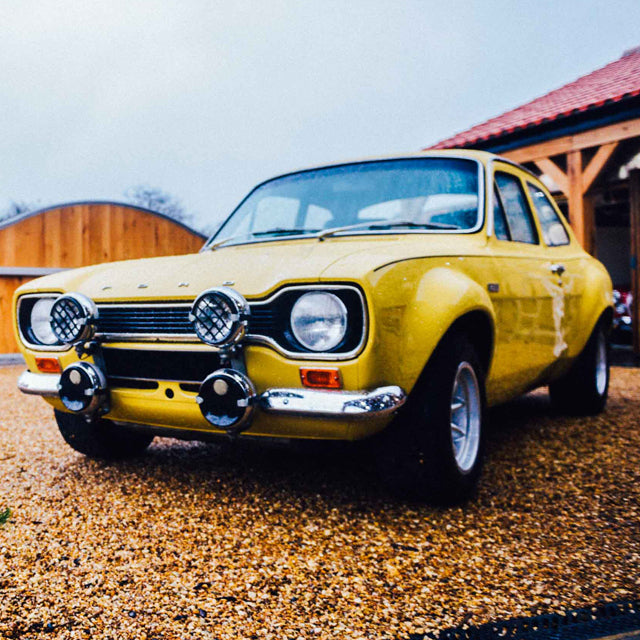When was the last time you went for a drive just for the hell of it? No reason, no particular destination—just jump in the car and head out to a decent road nearby and go?
It’s been a habit of mine that I have to admit I got out of for quite some time. When I realised this, it led me to wondering why. My conclusion: it just wasn’t fun taking modern, fast cars out on local routes. The cars had become so capable that they didn’t come alive until they reached speeds wholly unsuitable for public roads.
But the roads hadn’t changed…so surely the problem could be solved by changing the car?
That realization led me to classic cars, which led me to this Daytona Yellow Mark 1 Escort RS1600 BDA.
The Mark 1 Ford Escort was introduced in the United Kingdom at the end of 1967, making its show debut at the Brussels Motor Show in January 1968. It replaced the popular, long-running Anglia and instantly became a commercial success—by June 1974, Ford announced the two millionth had been sold.

Commercial success was matched with competitive achievement as Mark 1 Escorts went on to become one of the most efficacious rally cars of all time. The Ford works team was practically unbeatable in the late 1960s / early 1970s, their most famous victory being the 1970 London to Mexico World Cup Rally (famously driven by Hannu Mikkola accompanied by co driver, Gunner Palm).
It’s a history that resonates through the look and smell of the car. The bubble arches, huge period Cibie lights and famous “dog bone” grill seem to contrast with the immaculate paintwork. It really should be covered in mud. As I climb into the period bucket seats and click the harness into place, it’s easy to imagine the voice of Gunner Palm running through pace notes next to me. A couple of pumps of the throttle to feed the twin Weber carburetors, turn the key, and that famous Cosworth engine rumbles into life.
This car has recently been to Bogg Brothers in North Yorkshire for a rolling road tune, and produced 170 horsepower at the wheels. The engine is capable of producing a good deal more than that with various tweaks and performance part upgrades. The current configuration and tune seems more than adequate for the road, though.



It’s simple in here. No stereo, a few toggle switches, the neat little instrument pod with a large tachometer to the left, speedo, and four, smaller, ancillary gauges. An optional co-driver’s lamp on a flex, too. A simple dash by today’s standards, and shallow.
Today’s cars have ever deeper dashboards, here you feel like a goldfish, nose up against the glass.
The one thing that does strike you is the deeply dished steering wheel, not least because as standard they are slightly offset, and subsequently my left hand is slightly nearer to me than my right as I grip the wheel. You soon get used to it, but at the outset, it’s a strange sensation.
The gauges tell me it’s time to go. No “Sports” mode button to press, no driving aids to disengage—just me, the car and the road. (And a spare can of fuel, portable jump starter, and a fire extinguisher. After all, this RS is 43 years old and eccentricities may have crept in.)


As we join the open road and accelerate, it’s clear that with 170 horsepower at the wheels and a weight around 1,765 lbs (800 kgs) this old timer is no slouch. The BDA engine seems much happier at higher revs and demands to be driven hard. There’s an eager feeling from the car, and it feels like we’re flying. A glance at the speedometer reminds me of precisely what led me to this moment.
Even hustling along, we’re still in reasonable double digits akin to British motorway cruising speeds, but the car is alive and feels like a Terrier pulling on its lead during a morning walk.
The car devours corners with ease, the rear digging in as I gently feed in the power. The steering is perfectly geared and provides excellent feedback, especially if compared to the current crop of cars with electric steering. On fast sweeping corners, the car is neutral and well-behaved with little body roll. In tighter, lower geared corners, it’s easy to provoke mild oversteer on the exit (if you want to, and you would, wouldn’t you?)
Feedback, both through the chassis and steering wheel, are such that the RS never throws up any surprises and rapid, safe, fun progress can be made. The disc brakes also work reassuringly well and there is no snatching or locking up, even when pressed firmly into action.
As mentioned previously, the car does require a firm grip. I’ve become so accustomed to fingertip steering in modern cars that the need to wrestle the RS’s steering means I’m sat closer to the wheel than usual just to get leverage in tighter corners. It all just adds to the point, though. I’m working harder, and enjoying myself more, in the RS—at half the speeds I would in a modern performance car.

As we head for home, sweeping through the long fast corners of the local country roads, it’s become a little damp now and the Yokohoma Advan AO48 semi-slick tyres start to show their weakness, namely shifting standing water.
Returning home into the garage, I jump out and look back at the car, now wet through and with at least a mild spattering of mud. Job done, fun had, and speed limits barely stretched.
Manufacturers of modern performance cars take note, you might want to play Top Trumps with your competitors, but we want to drive cars, and enjoy them, on the roads.
May I suggest an Escort of your own?






















































